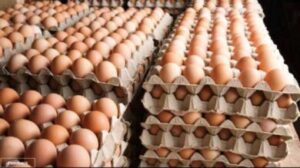Last updated on July 30, 2025
If you’re running a commercial poultry farm in Nigeria, you’ve probably asked: How many crates of eggs can 1000 layers produce? This is the core of poultry egg production per crate, daily egg output from layers, and ultimately, your farm’s profitability.
Whether you want to calculate your egg sales revenue, track flock performance, or plan for the cost of feeding 1000 layers, this guide will help you get accurate numbers, avoid common mistakes, and maximize your profit per crate of eggs.
“If you don’t keep records, you’re just guessing. You need to know how many eggs you’re getting, how much feed you’re using, and what your costs are. That’s the only way to know if you’re making money or losing it.”
— Dr. Jacquie Jacob, University of Kentucky
Source
How Many Eggs Do 1000 Layers Lay Per Day? (Laying Rate & Egg Yield)
- Laying percentage (laying rate): % of hens laying an egg each day.
- Commercial breeds (Lohmann Brown, ISA Brown, Hy-Line) can reach 85–95% at peak laying period.
- Most Nigerian farms average 80–90% due to feed, age, and environment.
“A good commercial layer flock should average about 85 to 90 percent production during the first year of lay. This means that on any given day, 85 to 90 percent of the hens are laying an egg.”
— Dr. Darrin Karcher, Purdue University
Source
Formula:
Eggs per day = Number of layers × Laying rate (as a decimal)
Example: 1000 layers × 0.9 = 900 eggs per day
Egg Crates per Day from Layers: Nigeria Guide
In Nigeria, a crate of eggs means 30 eggs (one tray).
Crates per day = Eggs per day ÷ 30
Example: 900 eggs ÷ 30 = 30 crates per day
Feed, Egg Yield, and Crate Conversion
While feed intake is crucial for egg production, this article focuses on egg yield and crate output.
For a deeper breakdown of feed efficiency, savings, and the cost-to-profit framework, see our full Feed Cost Calculator guide.
Feed vs. Output Table for 1000 Layers
| Laying Rate | Eggs/Day | Crates/Day | Feed/Day (kg)* | Feed/Crate (kg)* |
|---|---|---|---|---|
| 80% | 800 | 26.7 | 115 | 4.31 |
| 90% | 900 | 30 | 115 | 3.83 |
| 95% | 950 | 31.7 | 115 | 3.63 |
*Feed values are for illustration. For full feed-to-egg ratio and cost analysis, use our layer ROI calculator.
Seasonality: Harmattan & Rainy Season Effects
Egg production in Nigeria is seasonal.
- Harmattan: Cold, dry winds can stress birds and reduce laying rate by 5–10%.
- Rainy season: Humidity and lower daylight hours often cause a noticeable drop in lay rate and egg size.
- Tip: Use supplemental lighting and adjust feed to maintain output during these periods.
“During the rainy season, my egg production always drops, but by keeping good records and adjusting feed, I can still get close to 900 eggs a day from my 1,000 layers. Tracking makes all the difference.”
— Mrs. Oluchi Eze, poultry farmer, Enugu State
[Source: Interview on AgroNigeria TV]
How to Calculate Layer Profit in Nigeria (Egg Sales Revenue & ROI)
- Daily revenue: Crates per day × Crate price (₦). For the latest crate of eggs in Nigeria price, check your local market (₦3,500–₦4,500).
- Daily feed cost: 110–120g feed per bird × 1000 = 110–120kg/day × feed price per kg.
- Other costs: Labour, meds, electricity, mortality.
- Egg crate profit margin: (Egg sales revenue – Total costs) ÷ Crates per day.
For a full cost-to-profit breakdown, see our Feed Cost Calculator.
Checklist for Flock Performance Tracking
- Am I recording daily egg counts and feed used?
- Is my laying rate within 80–95% for my breed and flock age?
- Any sudden production drop? (Check feed, water, lighting, health)
- Are all waterers clean and working?
- Is lighting consistent (14–16 hours/day)?
- Have I culled old or sick hens recently?
- Am I tracking crate price fluctuation in Nigeria?
Frequently Asked Questions
How many crates of eggs can 1000 layers produce per day?
With a laying rate of 85–90%, expect 28–30 crates per day (900 eggs ÷ 30 = 30 crates).
What is the egg laying capacity of 1000 chickens?
At peak, 1000 commercial layers can lay 900–950 eggs per day, or 30–32 crates.
How do I calculate profit per crate of eggs?
Subtract your total daily costs (feed, labour, etc.) from your daily egg sales revenue, then divide by crates per day.
What causes a sudden drop in egg production?
Feed changes, poor water, disease, heat stress, or lighting changes. Walk your flock daily and check for these issues.
How do I track poultry farming profitability in Nigeria?
Keep daily records of egg output, feed used, costs, and crate prices. Use a calculator for monthly ROI.
How do I improve egg size and quality?
To optimize your flock’s diet, see our full guide to chicken feed for egg production.
What’s the best way to reduce feed waste?
Use anti-spill feeders, raise feeders to back height, and avoid overfilling. Store feed in airtight bins.
How do I handle production drops during the rainy season?
Provide supplemental lighting, keep the coop dry and well-ventilated, and monitor for disease outbreaks.
How long do layers stay productive?
Most commercial layers are most productive from 22 to 80 weeks of age. After that, egg numbers and shell quality usually decline.
Can I use local breeds for commercial egg production?
Local breeds lay fewer eggs and are less efficient than commercial hybrids. They may be better for backyard or dual-purpose flocks.
How do I know if my hens are too old to lay?
If your laying rate drops below 60% and hens are over 80 weeks old, it may be time to cull and replace them.
What’s the best way to track egg production?
Use a simple notebook, spreadsheet, or farm management app. Record daily egg count, feed used, and any changes in management.
How do I prevent egg-eating in my flock?
Collect eggs frequently, provide enough nest boxes, and ensure hens have enough calcium. Remove any egg-eating birds quickly.
How do I sell more eggs or get better prices?
Build relationships with local markets, restaurants, and shops. Clean, well-packaged eggs and reliable delivery can help you get premium prices.
What’s the average profit margin for a layer farm?
Profit margins vary, but well-managed farms can see 10–20% after feed and operating costs. High feed prices or low egg prices can reduce this.
Can I mix my own layer feed?
Yes, but only if you have access to quality ingredients and a reliable formula. Poorly balanced feed can reduce egg output and health.
Calculate Your Own Egg Crates and Profit
Enter your flock size, laying rate, and crate price below to see your daily and monthly profit instantly. No spreadsheets required.
Layer Egg Production & Crate Calculator
Estimate your daily, weekly, and monthly egg output in various units, including Nigerian crate standards.
Flock Details
Typical commercial breeds lay between 85-95% at peak.
Estimated Egg & Crate Output
Weekly Projections
Monthly Projections (Approx. 30.44 days/month)
These estimates provide a strong foundation for planning. Always monitor your flock’s health and adjust as needed.
With the right tools, strategies, and a clear financial plan, you’re well on your way to turning your poultry farm into a profitable venture. Keep accurate records, stay adaptable, and keep learning – your business will thrive!
Conclusion
Success in egg production isn’t about guessing or hoping for the best—it’s about tracking your numbers, understanding what affects your output, and making smart, timely changes. Whether you raise 50 hens or 5,000, knowing how many crates you produce daily and monthly puts you in full control of your planning, budgeting, and profitability.
Use the checklists, expert advice, and calculator in this guide to benchmark your farm, catch problems early, and keep your business moving forward. Remember, the most profitable poultry farmers are those who pay attention, adapt quickly, and never stop learning.
Ready to see real results? Start tracking today, use the calculator, and share your numbers or questions below. Your next breakthrough could be just one adjustment away!


